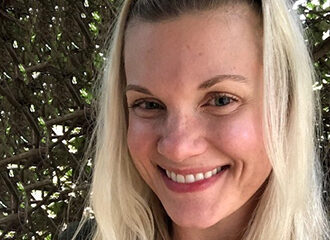Written by: Erin Birely, LCPC
Alumni Services Coordinator, The Renfrew Center

As the days shorten and the chill of autumn deepens into winter, many people experience a noticeable shift in mood. For some, this change is more than just the “winter blues;” it’s Seasonal Affective Disorder (SAD), a type of depression that follows a seasonal pattern. At the same time, the colder months can also bring about—or exacerbate—challenges with food and body image. For individuals struggling with eating disorders, the intersection of these two conditions can create a perfect storm of distress in the darker seasons.
What Is Seasonal Affective Disorder (SAD)?
Seasonal Affective Disorder is a subtype of major depressive disorder (MDD) with a seasonal pattern—most commonly emerging in late fall or early winter and subsiding in the spring or summer. It’s believed to be related to the lack of sunlight, which disrupts circadian rhythms, lowers serotonin levels (a neurotransmitter that affects mood), and alters melatonin production (which impacts sleep and mood).
Common symptoms of SAD include:
- Persistent low mood
- Fatigue and low energy
- Oversleeping (hypersomnia)
- Difficulty concentrating
- Social withdrawal
The Intersection of SAD and Eating Disorders
The relationship between SAD and eating disorders is multifaceted, and both can impact each other. As the winter season sets in, biological and environmental factors—such as decreased daylight, disrupted routines, and holiday-related stress—can exacerbate underlying vulnerabilities. People with SAD may experience changes in appetite or stronger cravings for certain types of food. For those in eating disorder recovery, these shifts can sometimes feel confusing, shameful, or triggering and may increase the pull toward old patterns like restricting, bingeing, or compensatory behaviors.
Additionally, the increased focus on family and social gatherings can be stressful, especially when you’re around people who may not fully support your recovery or whose presence triggers feelings of loneliness. When we’re not feeling genuinely and authentically connected with others, it can increase feelings of sadness and decrease motivation. Many of these gatherings also have a focus around large quantities of food or a variety of dishes that feel “special.” These aspects can lead to an increase in eating disorder thoughts and increased stress around attending. Meanwhile, social media and societal messaging about “holiday weight gain” or “New Year’s resolutions” can fuel body dissatisfaction and reinforce disordered thoughts and behaviors.
For someone already feeling low due to SAD, these added stressors can make the winter months especially difficult.
Both SAD and eating disorders often share underlying psychological traits such as:
- Perfectionism
- Low self-esteem
- Negative body image
- Avoidant coping mechanisms for stress or emotional pain
When someone is already dealing with disordered eating, the added emotional weight of SAD can intensify restrictive or binge-purge cycles. Conversely, someone with SAD might develop disordered eating patterns as a means of self-soothing or seeking control in a season that feels heavy and uncertain.
Another factor that impacts the connection between SAD and eating disorders is neurobiological. Serotonin, the brain chemical that regulates mood, appetite, and sleep, plays a crucial role in both SAD and eating disorders. During the winter months, serotonin levels naturally drop, which may explain both the low mood of SAD and the increased cravings for foods that boost serotonin temporarily. This can increase urges for foods that the eating disorder has deemed off limits, or that cause guilt and shame when we consume them.
READ MORE: Eating Disorder Recovery During the Holidays: What to Expect & How to Maintain
Who’s Most at Risk?
While SAD and eating disorders can affect anyone, certain individuals may be at higher risk of experiencing both. Both conditions have been shown to disproportionately affect those assigned female at birth. Those living in northern latitudes are also at an increased risk, as their winter days are shorter and darker than those living at more southern latitudes. Anyone with a history of depression, anxiety, or eating disorders can also be at risk.
Seasonal Affective Disorder Signs to Watch For
If you or someone you love appears to be struggling during the fall and winter months, look out for these overlapping signs:
- Changes in appetite, especially increased cravings, or restriction
- Weight fluctuations
- Withdrawal from social activities
- Excessive sleep or fatigue
- Irritability, sadness, or hopelessness
- Preoccupation with food, dieting, or body image
- Episodes of bingeing or purging
- Anxiety around meals or weight gain
Treatment and Support
The good news is that both Seasonal Affective Disorder (SAD) and eating disorders can be treated, and with support, people experiencing them can improve. One of the most effective treatments for SAD is light therapy (aka phototherapy), which involves sitting near a specially designed light box that mimics natural sunlight. This can help regulate circadian rhythms and improve mood.
Psychotherapy can help individuals address distorted thoughts around food, body image, and seasonal changes. CBT-SAD is a specialized form that focuses on the negative thoughts and behaviors that occur in the winter months. Additionally, antidepressants, particularly SSRIs (selective serotonin reuptake inhibitors), can be effective for both SAD and eating disorders, especially when symptoms are moderate to severe. For those continuing to struggle with food and nutrition, working with a registered dietitian who specializes in eating disorders can help re-establish consistent and flexible eating patterns and challenge food-related fears.
Outside of professional help, individuals struggling with SAD and eating disorders can also focus on maintaining a consistent sleep schedule and engaging in movement that brings them joy and connection. Practicing mindfulness and journaling can also be helpful additions to therapy. Putting extra effort into maintaining connections with supportive friends, family, or peers, and asking for their help when needed, can provide important emotional support.
Conclusion
Winter can be a difficult time for many, especially for those who feel the emotional weight of the season alongside food and body image struggles. Understanding the connection between SAD and eating disorders is an important first step, and noticing early signs – such as changes in mood, appetite, or energy – can help you seek support sooner. Because recovery is complex, treatment often works best when it includes multiple forms of support: therapy, medical care, nutrition guidance, and connection with a supportive community. With the right combination of help and support, it’s possible to navigate even the darkest seasons and hold onto hope that light can return. Reach out to The Renfrew Center to take your first step.
Struggling with disordered eating or body image? The Renfrew Center provides compassionate care for all bodies. Contact us today to get started.
If you, a loved one, or a patient is experiencing an eating disorder, help is available. Contact The Renfrew Center’s team by phone at 1-(800) 736-3739 or complete our online form.



